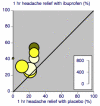Ibuprofen with or without an antiemetic for acute migraine headaches in adults
- PMID: 20927770
- PMCID: PMC4161114
- DOI: 10.1002/14651858.CD008039.pub2
Ibuprofen with or without an antiemetic for acute migraine headaches in adults
Update in
-
Ibuprofen with or without an antiemetic for acute migraine headaches in adults.Cochrane Database Syst Rev. 2013 Apr 30;2013(4):CD008039. doi: 10.1002/14651858.CD008039.pub3. Cochrane Database Syst Rev. 2013. PMID: 23633348 Free PMC article.
Abstract
Background: Migraine is a common, disabling condition and a burden for the individual, health services and society. Many sufferers do not seek professional help, relying instead on over-the-counter analgesics. Co-therapy with an antiemetic should help to reduce symptoms commonly associated with migraine headaches.
Objectives: To determine efficacy and tolerability of ibuprofen, alone or in combination with an antiemetic, compared to placebo and other active interventions in the treatment of acute migraine headaches in adults.
Search strategy: We searched Cochrane CENTRAL, MEDLINE, EMBASE and the Oxford Pain Relief Database for studies through 22 April 2010.
Selection criteria: We included randomised, double-blind, placebo- or active-controlled studies using self-administered ibuprofen to treat a migraine headache episode, with at least 10 participants per treatment arm.
Data collection and analysis: Two review authors independently assessed trial quality and extracted data. Numbers of participants achieving each outcome were used to calculate relative risk and number needed to treat (NNT) or harm (NNH) compared to placebo or other active treatment.
Main results: Nine studies (4373 participants, 5223 attacks) compared ibuprofen with placebo or other active comparators; none combined ibuprofen with a self-administered antiemetic. All studies treated attacks with single doses of medication. For ibuprofen 400 mg versus placebo, NNTs for 2-hour pain-free (26% versus 12% with placebo), 2-hour headache relief (57% versus 25%) and 24-hour sustained headache relief (45% versus 19%) were 7.2, 3.2 and 4.0, respectively. For ibuprofen 200 mg versus placebo, NNTs for 2-hour pain-free (20% versus 10%) and 2-hour headache relief (52% versus 37%) were 9.7 and 6.3, respectively. The higher dose was significantly better for 2-hour headache relief than the lower dose. Soluble formulations of ibuprofen 400 mg were better than standard tablets for 1-hour, but not 2-hour headache relief.Associated symptoms of nausea, vomiting, photophobia and phonophobia and functional disability were reduced within 2 hours, and fewer participants used rescue medication with ibuprofen compared with placebo. Similar numbers of participants experienced adverse events, which were mostly mild and transient.Ibuprofen 400 mg did not differ from rofecoxib 25 mg for 2-hour headache relief, 24-hour headache relief or use of rescue medication.
Authors' conclusions: Ibuprofen is an effective treatment for acute migraine headaches, providing pain relief in about half of sufferers, but complete relief from pain and associated symptoms for only a minority. NNTs for all efficacy outcomes were better with 400 mg than 200 mg in comparisons with placebo, and soluble formulations provided more rapid relief. Adverse events were mostly mild and transient, occurring at the same rate as with placebo.
Figures






References
References to studies included in this review
-
- Codispoti JR, Prior MJ, Fu M, Harte CM, Nelson EB. Efficacy of nonprescription doses of ibuprofen for treating migraine headache. A randomized controlled trial. Headache. 2001;41(7):665–79. DOI: 10.1046/j.1526-4610.2001.041007665.x. - PubMed
-
- Diener HC, Bussone G, de Liano H, Eikermann A, Englert R, Floeter T, et al. The EMSASI Study Group. Placebo-controlled comparison of effervescent acetylsalicylic acid, sumatriptan and ibuprofen in the treatment of migraine attacks. Cephalalgia. 2004;24(11):947–54. DOI: 10.1111/j.1468-2982.2004.00783.x. - PubMed
-
- Ellis GL, Delaney J, DeHart DA, Owens A. The efficacy of metoclopramide in the treatment of migraine headache. Annals of Emergency Medicine. 1993;22(2):191–5. DOI: 10.1016/S0196-0644(05)80201-X. - PubMed
-
- Goldstein J, Silberstein SD, Saper JR, Ryan RE, Jr, Lipton RB. Acetaminophen, aspirin, and caffeine in combination versus ibuprofen for acute migraine: results from a multicenter, double-blind, randomized, parallel-group, single-dose, placebo-controlled study. Headache. 2006;46(3):444–53. DOI: 10.1111/j.1526-4610.2006.00376.x. - PubMed
-
- Kellstein DE, Lipton RB, Geetha R, Koronkiewicz K, Evans FT, Stewart WF, et al. Evaluation of a novel solubulized formulation of ibuprofen in the treatment of migraine headache: a randomized, double blind, placebo-controlled, dose-ranging study. Cephalagia. 2001;20(4):233–43. DOI: 10.1046/j.1468-2982.2000.00055.x. - PubMed
References to studies excluded from this review
-
- Havanka-Kanniainen H. Treatment of acute migraine attack: ibuprofen and placebo compared. Headache. 1989;29(8):507–9. - PubMed
-
- Kalita J, Yadav RK, Misra UK. A comparison of migraine patients with and without allodynic symptoms. Clin J Pain. 2009;25(8):696–8. - PubMed
-
- Kloster R, Nestvold K, Vilming ST. A double-blind study of ibuprofen versus placebo in the treatment of acute migraine attacks. Cephalalgia. 1992;12(3):169–71. - PubMed
-
- Nebe J, Heier H, Diener HC. Low-dose ibuprofen in self-medication of mild to moderate headache: a comparison with acetylsalicylic acid and placebo. Cephalalgia. 1995;15(6):531–5. - PubMed
-
- Pearce I, Frank GJ, Pearce JM. Ibuprofen compared with paracetamol in migraine. The Practioner. 1983;227(1377):465–7. - PubMed
Additional references
-
- Bigal ME, Serrano D, Reed M, Lipton RB. Chronic migraine in the population: burden, diagnosis, and satisfaction with treatment. Neurology. 2008;71(8):559–66. DOI: 10.1212/01.wnl.0000323925.29520.e7. - PubMed
-
- Clarke CE, MacMillan L, Sondhi S, Wells NEJ. Economic and social impact of migraine. The Quarterly Journal of Medicine. 1996;89(1):77–84. - PubMed
Publication types
MeSH terms
Substances
LinkOut - more resources
Full Text Sources
Other Literature Sources
Medical
Miscellaneous

